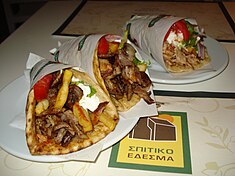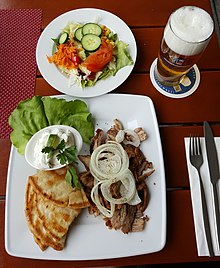Gyros, sometimes anglicized as a gyro[2][3][4] (/ˈjɪəroʊ, ˈdʒɪər-, ˈdʒaɪr-/; Greek: γύρος, romanized: yíros/gyros, lit. 'turn', pronounced [ˈʝiros]) in some regions, is meat cooked on a vertical rotisserie, then sliced and served wrapped or stuffed in pita bread, along with other ingredients such as tomato, onion, fried potatoes, and tzatziki. In Greece, it is normally made with pork[5] or sometimes with chicken, whilst beef and lamb are also used in other countries.[6]
 | |
| Alternative names | Gyro[1] |
|---|---|
| Type | Meat wrap |
| Course | Main course |
| Place of origin | Greece |
| Serving temperature | Hot |
| Main ingredients | Meat: pork, chicken, beef, or lamb |
Name
The name comes from the Greek γύρος (gyros, 'circle' or 'turn'). It is a calque of the Turkish döner, from dönmek, also meaning "turn".[7]
In Athens and other parts of southern Greece, the skewered meat dish elsewhere called souvlaki is known as kalamaki, while souvlaki is a term used generally for gyros, and similar dishes.[8]
In Greek, "gyros" is a nominative singular noun, but the final 's' is often interpreted in English usage as plural,[9] leading to the singular back-formation "gyro".[10] The Greek pronunciation is [ˈʝiɾos], though some English speakers pronounce it /ˈdʒaɪroʊ/.
Similar dishes
Gyros is made in a similar manner to other dishes such as the Arab shawarma, Canadian donair, Mexican al pastor, and the Turkish döner kebab.[11]


History

Grilling a vertical spit of stacked meat and slicing it off as it cooks was developed in Bursa[12] in the 19th century in the Ottoman Empire. After the 1922-23 Population exchange between Greece and Turkey, the Greeks brought their variation with them to Greece. Following World War II, Gyros made with lamb (called as döner kebab by some restaurants) was present in Athens.[13][12] It was likely introduced by immigrants from Anatolia and the Middle East.[5][14] The Greek version is normally made with pork and served with tzatziki, and became known as gyros.[15][16] Chicken Gyros is also very popular however.[citation needed]
By 1970, gyros wraps were already a popular fast food in Athens, as well as in Chicago and New York City.[17][18][19] At that time, although vertical rotisseries were starting to be mass-produced in the US by Gyros Inc.[17] of Chicago, the stacks of meat were still hand-made. There are several claimants to have introduced the first mass-produced gyros to the United States, all based in the Chicago area in the early 1970s, and of Greek descent. One of them, Peter Parthenis, has said that the mass-produced gyro was first conceptualized by John and Margaret Garlic; John Garlic was a Jewish car salesman who later ran a restaurant featuring live dolphins.[19]
The Halifax donair in Canada which was based on the Greek gyros was invented in the 1970s by Peter Gamoulakos. Originally from Greece, he started selling Greek gyros (a pita stuffed with grilled lamb and tzatziki) from his restaurant located off the Bedford Highway.[20]
Preparation
In Greece, gyros is normally made with pork, though other meats are used in other countries.[15] Chicken is common, and lamb or beef may be found more rarely.[citation needed] Typical American mass-produced gyros are made with finely ground beef mixed with lamb.[19]
For hand-made gyros, meat is cut into approximately round, thin, flat slices, which are then stacked on a spit and seasoned. Fat trimmings are usually interspersed. Spices may include cumin, oregano, thyme, rosemary, and others.[citation needed] The pieces of meat, in the shape of an inverted cone, are placed on a tall vertical rotisserie, which turns slowly in front of a source of heat or broiler. As the cone cooks, lower parts are basted with the juices running off the upper parts. The outside of the meat is sliced vertically in thin, crisp shavings when done.[15][21]
The rate of roasting can be adjusted by varying the intensity of the heat, the distance between the heat and the meat, and the speed of spit rotation, thus allowing the cook to adjust for varying rates of consumption.[citation needed]
In Greece, it is customarily served in an oiled, lightly grilled piece of pita, rolled up with sliced tomatoes, chopped onions, lettuce, and fried potatoes, sometimes topped with tzatziki, or, sometimes in northern Greece, ketchup or mustard.[22][23][24]
See also
References
External links

 The dictionary definition of gyros at Wiktionary
The dictionary definition of gyros at Wiktionary


